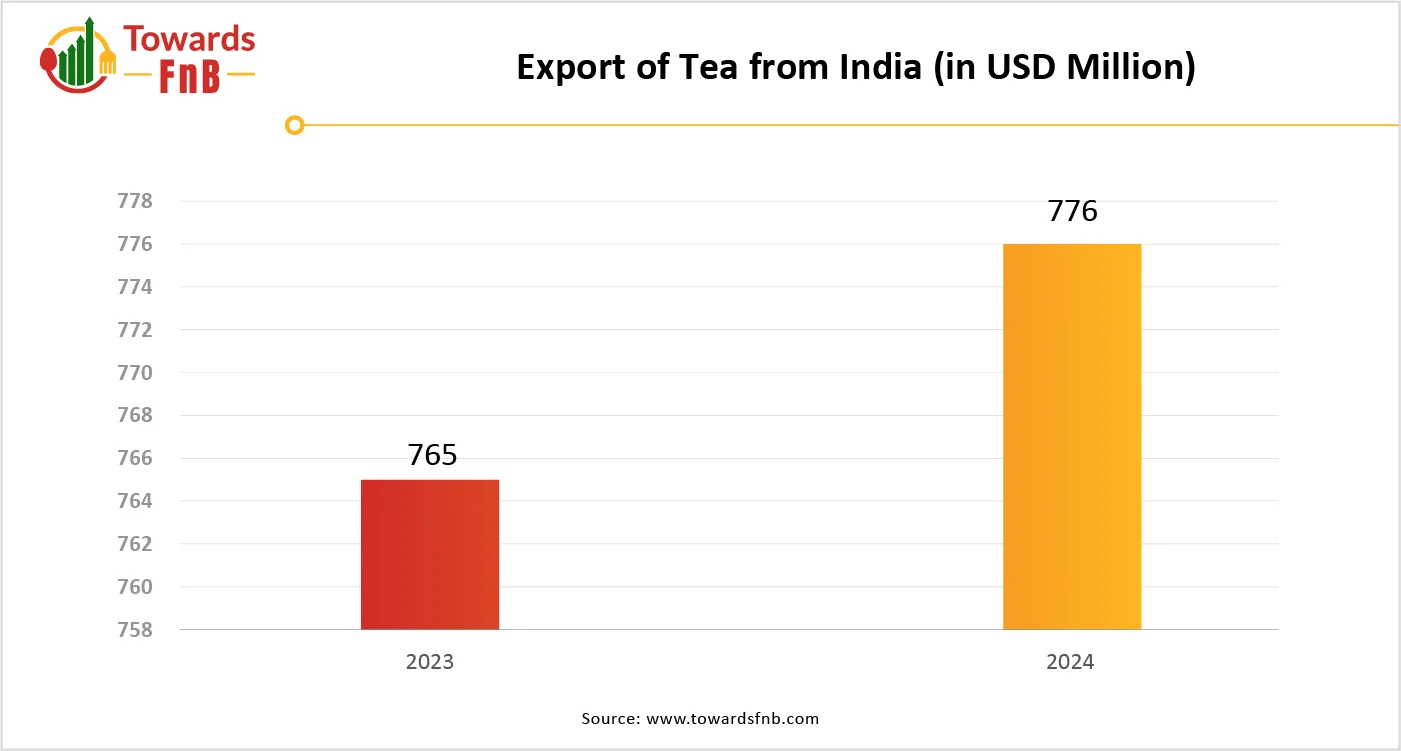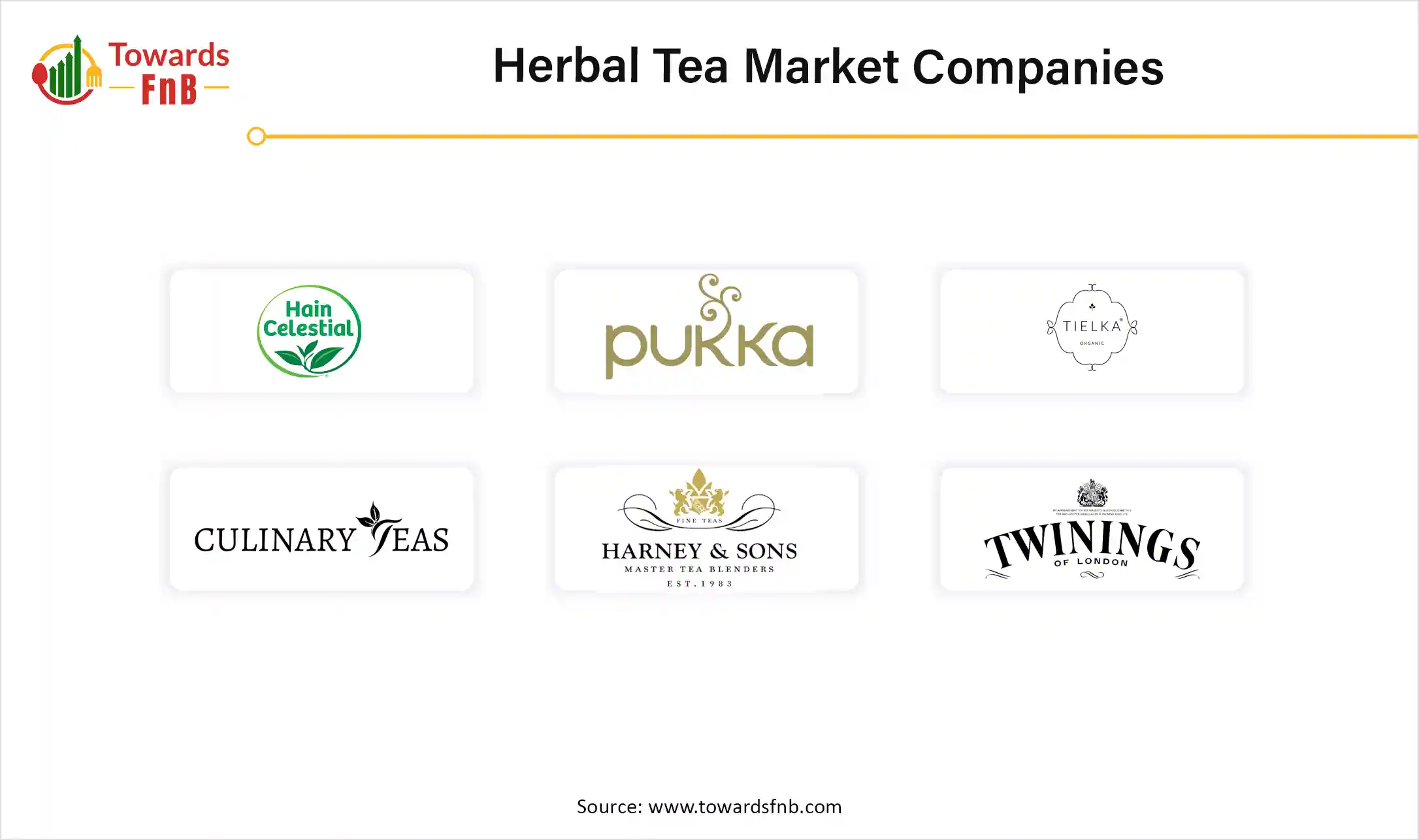December 2025
The global herbal tea market size was valued at USD 3.87 billion in 2024 and is expected to grow steadily from USD 4 billion in 2025 to reach nearly USD 5.36 billion by 2034, with a CAGR of 3.3% during the forecast period from 2025 to 2034. The rapid growth in the market is seen due to a shift towards natural and organic tea beverages and a change in preference of the consumers towards healthy alternatives.

| Study Coverage | Details |
| Growth Rate from 2025 to 2034 | CAGR of 3.3% |
| Market Size in 2025 | USD 4 Billion |
| Market Size in 2026 | USD 4.13 Billion |
| Market Size by 2034 | USD 5.36 Billion |
| Largest Market | Asia Pacific |
| Base Year | 2024 |
| Forecast Period | 2025 to 2034 |
| Regions Covered | North America, Europe, Asia-Pacific, Latin America, and Middle East & Africa |
The herbal tea market has been growing at a significant rate recently due to its health benefits and a very good alternative to traditional tea, like functional tea, detox tea, and many more which have antibacterial, antioxidant, and anti-inflammatory properties. The herbal tea is prepared from the decoction or infusion of various types of herbs, flowers, and spices, which offers numerous health benefits. Herbal teas are consumed hot or cold, the natural and health benefits associated with it help the market to grow and attract consumers.
The adoption of healthy habits in terms of consumption of food is a crucial factor in fuelling the growth of the herbal tea market. The growing cases of chronic diseases such as diabetes, obesity, viral diseases, and cardiovascular diseases increase the demand for herbal tea in the market. The use of herbal tea as an alternative to traditional tea has been beneficial to patients with a special diet. Herbal teas are rich in nutritional properties and help in overcoming health conditions like insomnia, and digestion. Hence, the market will see significant growth in the forecasted period.
The herbal tea is produced by the traditional decoction method but the introduction of a new and advanced method in the production of herbal tea during packaging of the raw material in the packages will help preserve the aroma and taste of the tea for longer duration and this also improves the consumer experience and attracts consumers to buy the product and increase the demand for production of more goods. The flavor innovation also attracts consumers, the customization of flavor according to consumer preference also helps the market to grow and change the perspective towards traditional herbal tea. The use of eco-friendly packaging material and the adoption of single-use packaging helps the consumer adopt the use of herbal tea in the busy lifestyle due to convenient usage.
The high cost of herbal tea compared to that of traditional tea is a challenging aspect that hinders the growth of the herbal tea market. Consumers look for cost-effective options as the growing middle-class population has budget constraints and the availability of cost-effective options reduces the purchase of premium and organic herbal tea and restricts the growth of the market. The high price of raw materials increases the price of production and ultimately increases the cost of the product. However, the rise in the demand for herbal tea will increase production which will help reduce the overall cost.
Asia Pacific Dominated the Herbal Tea Market in 2024.
The market has a significant place in traditional Chinese medicine as it possesses therapeutic properties, and due to changing lifestyles and shifts toward healthy diets drive this market to grow. The rapid urbanization and rising disposable income have helped the market to grow in the region. The demand for premium and organic herbal tea fuels the demand.
In China, India, and Japan the consumption of herbal tea a very high, due to the traditional and cultural beliefs associated with it, traditional Chinese medicine and Ayurveda both have medical advances and use of herbal tea in their culture. And the herbal tea's health benefits fuel the herbal tea market to grow significantly.
Chull Wali Chai, India’s most unapologetically bold herbal tea brand, launched its latest line of herbal teas, including calm code- ChamoMint Tea, clarity charge- Blue Voltage Tea, and ageless aura- Flirtatious Hibiscus Tea
North American Expects Significant Growth in the Market During the Forecast Period.
The growth is seen due to the increasing number of health-conscious individuals in the region. A strong demand for natural, organic, caffeine-free, and functional herbal tea. The change in consumer preferences and shift towards healthy lifestyles helps drive this market to grow significantly.
The USA has an increasing demand for chamomile, peppermint, and detox herbal tea due to their health benefits. Strong demand for natural and organic beverages in the region due to the growth of wellness trends and the rising influence of functional drinks in the fitness and wellness industry has fuelled the growth of the herbal tea market.

Herbal Tea Market Size By Region, 2024 to 2034 (USD Billion)
| By Region | 2024 | 2025 | 2026 | 2027 | 2028 | 2029 | 2030 | 2031 | 2032 | 2033 | 2034 |
| Europe | 1.01 | 1.04 | 1.07 | 1.1 | 1.13 | 1.16 | 1.19 | 1.23 | 1.26 | 1.3 | 1.34 |
| North America | 0.77 | 0.8 | 0.82 | 0.84 | 0.86 | 0.89 | 0.91 | 0.94 | 0.96 | 0.99 | 1.02 |
| Asia Pacific | 1.35 | 1.4 | 1.46 | 1.52 | 1.59 | 1.64 | 1.7 | 1.77 | 1.85 | 1.91 | 1.97 |
| Latin America | 0.31 | 0.32 | 0.33 | 0.34 | 0.35 | 0.36 | 0.38 | 0.39 | 0.4 | 0.41 | 0.43 |
| Middle East and Africa | 0.43 | 0.44 | 0.45 | 0.47 | 0.48 | 0.5 | 0.52 | 0.53 | 0.55 | 0.57 | 0.59 |
The Peppermint Segment Dominated the Herbal Tea Marketin 2024.
The growth of the market is increasing due to its refreshing taste and digestive benefits. The unique and different flavor attracts consumers to the market and increase the demand. The chamomile segment is seen to grow at a significant rate during the predicted period. The active compounds present in the chamomile, the compounds have properties like antioxidants, anti-inflammatory, and anti-bacterial properties driving the growth of the segment. It has potential health benefits over traditional tea and is preferred by most of the health-conscious consumers.
Herbal Tea Market Size By Type, 2024 to 2034 (USD Billion)
| By Type | 2024 | 2025 | 2026 | 2027 | 2028 | 2029 | 2030 | 2031 | 2032 | 2033 | 2034 |
| Chamomile | 0.58 | 0.6 | 0.62 | 0.64 | 0.66 | 0.68 | 0.71 | 0.73 | 0.75 | 0.78 | 0.8 |
| Peppermint | 0.85 | 0.88 | 0.9 | 0.91 | 0.94 | 0.95 | 0.97 | 1 | 1.04 | 1.03 | 1.07 |
| Hibiscus | 0.46 | 0.48 | 0.5 | 0.52 | 0.54 | 0.56 | 0.58 | 0.6 | 0.62 | 0.65 | 0.67 |
| Lemongrass | 0.39 | 0.4 | 0.42 | 0.43 | 0.45 | 0.47 | 0.48 | 0.5 | 0.52 | 0.54 | 0.56 |
| Ginger | 0.43 | 0.44 | 0.46 | 0.48 | 0.5 | 0.52 | 0.55 | 0.57 | 0.59 | 0.62 | 0.64 |
| Fruits | 0.31 | 0.32 | 0.33 | 0.35 | 0.36 | 0.38 | 0.39 | 0.41 | 0.42 | 0.44 | 0.46 |
| Blends | 0.54 | 0.57 | 0.59 | 0.62 | 0.64 | 0.67 | 0.7 | 0.73 | 0.76 | 0.8 | 0.83 |
| Others | 0.31 | 0.31 | 0.31 | 0.32 | 0.32 | 0.32 | 0.32 | 0.32 | 0.32 | 0.32 | 0.32 |
The Tea Bag Segment Dominated the Herbal Tea Market in 2024.
The changing lifestyle of individuals demands options in ready-to-use products such as tea bags. The tea bags are most used due to convenience and ease of preparation. The tea bags also help in maintaining hygiene as it is a single-use tea bag. The paperboard segment is seen to grow at a notable rate during the forecast period. Due to the shift towards eco-friendly and sustainable packaging and the containers also preserve the fresh aroma and taste.
Herbal Tea Market Size By Packaging, 2024 to 2034 (USD Billion)
| By Packaging | 2024 | 2025 | 2026 | 2027 | 2028 | 2029 | 2030 | 2031 | 2032 | 2033 | 2034 |
| Loose Tea | 0.77 | 0.81 | 0.84 | 0.88 | 0.92 | 0.96 | 1 | 1.04 | 1.08 | 1.13 | 1.18 |
| Paperboards | 0.7 | 0.72 | 0.74 | 0.76 | 0.78 | 0.8 | 0.82 | 0.84 | 0.86 | 0.89 | 0.91 |
| Aluminum Tins | 0.39 | 0.4 | 0.42 | 0.44 | 0.46 | 0.48 | 0.5 | 0.52 | 0.54 | 0.56 | 0.59 |
| Tea Bags | 2.01 | 2.07 | 2.13 | 2.19 | 2.25 | 2.31 | 2.38 | 2.46 | 2.54 | 2.6 | 2.67 |
The Supermarket and Hypermarket Segment Dominated the Market in 2024.
These markets offer consumers a wide and broad variety of options for a particular product and help in comparing other brands in terms of price and other essential parameters the availability of products in these stores increases the probability of getting a product readily and easily. The specialty stores are seen to grow at a notable rate during the predicted timeframe. These stores target the niche market and offer premium and organic products to the consumers.

By Type
By Packaging
By Distribution Channel
By Region
December 2025
December 2025
December 2025
December 2025